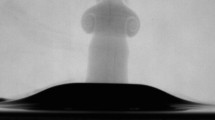Abstract
In hydraulic systems, it is common for air release to occur behind valves or throttles in the form of bubbles. These air bubbles can affect the behavior and the performance of these systems to a substantial extent. In the paper, gas release in a liquid flow behind an orifice is analyzed by optical methods for various operation points. The bubbles are observed with a digital camera, and a detection algorithm based on the Hough transformation is used to determine their number and size. The appearance of gas bubbles is very sensitive to the inlet and outlet pressure of the orifice. Gas bubbles are only observed if choking cavitation occurs. An empirical relationship between an adjusted cavitation number and the appearance of gas release is presented. It is assumed that the observed bubbles contain mostly air. With the applied pressure differences, up to 30 % of the dissolved air was degassed in the form of bubbles.








Similar content being viewed by others
References
Balewski B, Heine B, Tropea C (2009) Influence of Nozzle-flow turbulence on the primary spray breakup. (ICLASS 2009) In: Proceedings of the 11th Triennial international annual conference on liquid atomization and spray systems
Bongiovanni C, Chevaillier JP, Fabre J (1997) Sizing of bubbles by incoherent imaging: defocus bias. Exp Fluids 23:209–216
Bosserman BE (2012) Butterfly valves: torque, head loss, and cavitation analysis. American Water Works Association
Brennen CE (1995) Cavitation and bubble dynamics. Oxford University Press, Oxford
Chorazewski M, Dergal F, Sawaya T, Mokbel I, Grolier JPE, Jose J (2013) Thermophysical properties of Normafluid (ISO 4113) over wide pressure and temperature ranges. Fuel 105:440–450
Du W, Yang J (2009) A robust Hough transform algorithm for determining the radiation centers of circular and rectangular fields with subpixel accuracy. Phys Med Biol 54:555
Duda RO, Hart PE (1972) Use of the Hough transformation to detect lines and curves in pictures. Communications of the ACM 15
Girod G, Jaussi A, Rosset C, De Werra P, Hirt F, Kappenberger L (2002) Cavitation versus degassing: in vitro study of the microbubble phenomenon observed during echocardiography in patients with mechanical prosthetic cardiac valves. Echocardiography 19:531–536
Harris RM, Edge KA, Tilley DG (1994) The suction dynamics of positive displacement axial piston pumps. J Dyn Syst Meas Control 116:281–287
Heller W (2005) Hydrodynamische Effekte unter Berücksichtigung der Wasserqualität und ihre Messverfahren. Der Andere Verlag, Marburg
Holl JW (1970) Nuclei and cavitation. J Fluids Eng 92:681–688
Hough PVC (1962) Method and means for recognizing complex patterns. U.S. Patent No. 3.069.654
Illingworth J, Kittler J (1987) The adaptive Hough transform. IEEE Trans Pattern Anal Mach Intell 5:690–698
Iben U, Morozov A, Winklhofer E, Wolf F (2011) Laser-pulsed interferometry applied to high pressure fluid flow in micro channels. Exp Fluids 50:597–611
Jiang D, Li S, Edge KA, Zeng W (2012) Modeling and simulation of low pressure oil-hydraulic pipeline transients. Comput Fluids 67:79–86
Kolev NI (2007) Multiphase flow dynamics 3. Springer, Berlin
Kranenburg C (1974) Gas release during transient cavitation in pipes. J Hydraul Div 100:1383–1398
Lecoffre Y (1999) Cavitation: bubble trackers. Taylor & Francis, New York (1999)
Lichtarowicz A, Pearce ID (1974) Cavitation and aeration effects in long orifices. Cavitation Conference, Institution Mechanical Engineers, Edinburgh 19
Lin H, Deutsch S, Tarbell JM, Fontaine AA, Bianccucci BA (2000) Observation and quantification of gas bubble formation on a mechanical heart valve. J Biomech Eng 122:304–309
Mohammadi M, Sharp KV (2013) Experimental techniques for bubble dynamics analysis in microchannels: a review. J Fluids Eng 135:02102
Nurick WH (1976) Orifice cavitation and its effect on spray mixing. ASME Trans J Fluids Eng 98:681–687
Peng T (2010) Detect circles with various radii in grayscale image via Hough Transform. Matlab Central
Pollack GL (1991) Why gases dissolve in liquids. Science 251:1323–1330
Ruan J, Burton R (2006) Bulk modulus of air content oil in a hydraulic cylinder. ASME 2006 international mechanical engineering congress and exposition 259–269
Schrank K, Murrenhoff H, Stammen C (2013) Measurements of air absorption and air release characteristics in hydraulic oils at low pressure. ASME/BATH 2013 Symposium on fluid power and motion control
Shell Deutschland Oil GmbH (2006) Datasheet V-Oil-1404
Vacca A, Klop R, Ivantysynova M (2010) A numerical approach for the evaluation of the effects of air release and vapour cavitation on effective flow rate of axial piston pumps. Int J Fluid Power 11:33–45
Wiggert DC, Sundquist MJ (1979) The effect of gaseous cavitation on fluid transients. J Fluids Eng 101:79–86
Witt K (1976) Thermodynamisches Messen in der Ölhydraulik “Einführung und Übersicht”. O+P 416–424
Author information
Authors and Affiliations
Corresponding author
Rights and permissions
About this article
Cite this article
Iben, U., Wolf, F., Freudigmann, HA. et al. Optical measurements of gas bubbles in oil behind a cavitating micro-orifice flow. Exp Fluids 56, 114 (2015). https://doi.org/10.1007/s00348-015-1979-6
Received:
Revised:
Accepted:
Published:
DOI: https://doi.org/10.1007/s00348-015-1979-6




